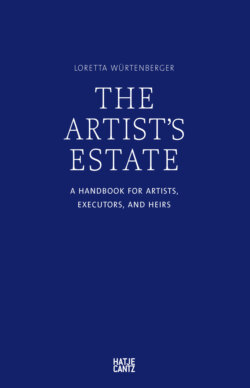Читать книгу The Artist's Estate - Группа авторов - Страница 13
2. An Artist’s Estate in the Commonly Understood Sense
ОглавлениеIn everyday language, the term “artist’s estate” refers to the artistic legacy, hence to the physical products of the artistic process and the intangible rights to them, as well as any accompanying documentation. All other components of the estate, such as other material assets or purely private items, play no primary role for the public examination of an artist and his or her work. Rather, insofar as present, either serve as financial protection for the heirs and /or the artistic estate or are ascribed to the private sphere of the artist and his or her dependents. In everyday language, these components are therefore not included under the term artist’s estate.
With respect to terminology, this understanding follows that of the field of archiving, which comprehends an estate as comprising all unofficial documents of a physical person that have arisen from their private, social, artistic-literary, or official activities and are acquired by an archive as a deposit or through donation or purchase.6 Correspondingly, the estate of a visual artist is regarded as all of his or her works as well as working materials and tools, notes, sketches, journals, and other documents.7 At the same time, the colloquial use of the term artist’s estate strains the legal definition factually as well as linguistically. In English-speaking countries, outside of specialist circles, a difference is only rarely made between the, in itself, temporally limited estate and the artist-endowed foundation that can follow from it in the eyes of the law.8
In continental Europe, many different forms of organizing an artistic legacy are also referred to in this respect as an artist’s estate. The spectrum of conceivable structures ranges from purely private-purpose, non-institutionalized administration to the purely charitable foundation set up for perpetuity, with strict legal provisions regarding the individuals who are active in it.
As a result of the conflating of artistic legacy and artist’s estate in colloquial speech, an artist’s estate is given its own, post-mortal identity, in which the aura of the artistic genius is still inherent. This can happen independently of whether this artistic aura receives an independent legal identity, by establishing an artist’s foundation for example. In this spirit, the American artist Jill Magid poses the question of what the character of an artist’s estate is. What is it really? Is it perhaps also a work of art? And do the individuals who administer an estate contribute to it creatively? In her own artistic practice, she tries to reconceptualize this question through making artists’ estates the subject of her work. With her Luis Barragán Project, she is attempting to convince the Fehlbaums, the Swiss husband-and-wife collectors and the owners of the furniture producer Vitra, to return the estate of the Mexican architectural icon Luis Barragán to his home. This estate is currently found in the Barragán Foundation in Switzerland, which is controlled by the Fehlbaums.9 Meant to assist in the decision is the offer of a diamond that the artist had pressed from a portion of Barragán’s ashes, for which the Mexican parliament had to grant special permission. Whether she will be successful with her offer remains to be seen. Magid has already examined aspects of the estate artistically in a previous work: with Auto Portrait Pending,10 she bequeathed her future mortal remains in diamond form to an art-collecting ring wearer. The term “body of work,” which is always an essential part of an artist’s estate, receives an entirely new, equivocal connotation. The German artist Peter Piller works from a different perspective. In the eponymous Archiv Peter Piller, he creates photo archives assembled from estate holdings and private collections and sorts them based on design elements as well as content-related similarities. They therefore become the work. Such approaches—as far removed as they are from precise legal definitions—can be very inspiring when one is responsible for an artist’s estate. If one regards the estate as an artwork per se, one dares consider one’s own role and possibilities more freely. This can be relieving, especially for the children of artists who might also see responsibility for the estate as a burden.
1 Helena Brack, in Katrina Strickland, Affairs of the Art: Love, Loss and Power in the Art World (Melbourne, 2013), p. 12.
2 In this book, we concentrate on the legal systems of Europe and the United States of America. Insofar as that is the case, generalizing statements are only made with reference to these legal systems. When specific statements concern individual legal systems within these geographical limitations, this is indicated.
3 See Palandt. Bürgerliches Gesetzbuch, edited by Peter Bassenge, Gerd Brudermüller, Uwe Diederichsen, Wolfgang Edenhofer, Jürgen Ellenberger, Christian Grüneberg, Helmut Heinrichs, Hartwig Sprau, Karsten Thorn, Walter Weidenkaff, 68th edition (Munich, 2008), § 1922, Rn. 7.
4 http://www.cross-channel-lawyers.de/tag/englisches-erbrecht-erbfolge-pflichtteil/ (accessed March 19, 2016).
5 On this see, for example, the US standard work on art law: Ralph E. Lerner and Judith Bresler, Art Law: The Guide for Collectors, Investors, Dealers & Artists (New York, 2005) or also the extensive information material of the Aspen Institute Artists-Endowed Foundations Initiative (AEFI); http://www.aspeninstitute.org/policy-work/nonprofit-philanthropy/artist-endowed/foundations (accessed March 19, 2016).
6 As defined in the glossary of selected archive-specific terms of the der Universitätsbibliothek Frankfurt am Main; http://www.ub.uni-frankfurt.de/archive/glossar.html (accessed March 19, 2016).
7 Roger Fayet and Deborah Favre, Umgang mit Künstlernachlässen in der Schweiz, SIK-ISEA study of March 17, 2014, p. 6.
8 Details on legal distinctions in the United States are named, for instance, in the information material of the Aspen Institute Artists-Endowed Foundations Initiative (see note 5); for generalized usage / use of the term in the United States, see for example Magda Salvessen and Diane Cousineau, Artists’ Estates: Reputations in Trust, (New Brunswick, New Jersey, 2005).
9 http://www.barragan-foundation.org/; http://www.welt.de/print-welt/article526454/ Luis-Barragan-das-Phantom-von-Mexiko.html (accessed March 19, 2016).
10 http://www.raebervonstenglin.com/index/artists/Jill-Magid/images.html (accessed March 19, 2016).
